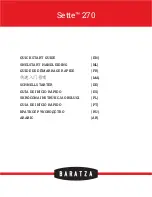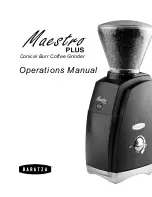
10
11
Fig. 7
Wire Cup Brush
Wire
Wheel
Brush
Fig. 8
Guard
Aluminum Oxide
For fast cutting, general purpose discs for most
metal jobs. Best for cold-rolled steel, stainless
steel or metals requiring tough, fast cutting, long
lasting abrasives.
Aluminum Zirconia Bi-Cut
Unique grit pattern is arranged in clusters for fast-
er stock removal and cleaning. Ideal for removing
paint from cars, boats, etc. without clogging.
Ceramic
Lasts up to 3 times longer than Aluminum Ox-
ide Discs. For general metal working. Ideal for
tough jobs.
WARNING
Everyone in the area must
wear protective clothing and safety goggles
or face shields. Fatigued wires and residue
will fl y off the brush with considerable force,
causing potential for serious injury.
WARNING
Never exceed Maximum
Safe Operating Speed of brush. Do not use
a damaged brush or one that is functioning
improperly (throwing wires, out-of-balance,
etc.). These conditions increase the pos-
sibility of further brush failure and possible
injury. Discard and replace damaged brushes
immediately.
Sanding Disc Selection
Use sanding discs and accessories that are:
• correct size as written on tool’s nameplate.
• rated at or above the RPM listed on the tool’s
nameplate.
• correct accessory, wheel type and grit for the job.
Refer to the table below to select the correct type
of sanding disc for your job. Generally, use 24 or
36 grit for heavy stock removal; 50, 60, or 80 grit
for medium stock removal and 120 grit for fi nishing.
Always begin with a coarse grit, using successively
fi ner grits to obtain the desired fi nish. See your
MILWAUKEE
Electric Tool Catalog for a complete
list of sanding discs.
USING WIRE BRUSHES
USING SANDING DISCS
Wire brushes are useful for removing rust, scale,
burrs, weld slag, etc.
Always install wire cup brushes according to the
accessory manufacterer’s instructions.
Test wheel for balance and loose or damaged wires
by letting it spin for one minute before applying it
to the workpiece. During this time, no one should
stand in front of or in line with it.
Control pressure and surface contact between
wheel and workpiece. Too much pressure causes
over-bending of wires and heat build-up causing
premature wire breaking, rapid dulling and reduced
brush life. Instead of more pressure, try a wire wheel
with more aggressive cutting action (increased wire
size, decreased wire length or different brush type
(knot type vs.crimped wire type).
Installing Backing Pad and Sanding Discs
1. Unplug the tool.
2. Wipe the accessories, disc nut and spindle to
remove dust and debris. Inspect the parts for
damage. Replace if needed.
3. Slip backing pad onto spindle with fl at side away
from gear case.
Fig. 9
Spindle
Backing
pad
Disc nut
Sanding
disc
When using a wire wheel brush, install guard ac-
cording to "Installing/Removing Accessories".
5. To tighten, press the spindle lock button while
turning disc nut clockwise with the spanner
wrench provided.
6. To remove backing pad and sanding disc, unplug
the tool and reverse the procedure.
Sanding
Hold tool at 5° to 15° angle to ensure proper sanding
pressure and control. Too great an angle will result
in too much pressure and could cause excessive
wear to the disc and workpiece. Too small an angle
will reduce control.
Use long, sweeping, side to side strokes, advancing
forward to produce the desired fi nish.
Fig. 10
For best result use only this portion of disc
Hold at a
Hold at a
5° to 15° angle
5° to 15° angle
Cross Sanding
When fi nishing a surface that has been prepared by
a coarse disc or wheel, sand at right angles to the
strokes made by the coarser disc. Finishing marks
left from previous sanding are easily seen and
removed for a uniform fi nish. Failure to cross sand
when changing from a coarse disc to a fi nishing disc
may result in deep scratches and circular marks.
Removing Welds or Hammer Marks
When removing welds or hammer marks, limit
coarse sanding to the immediate area. Use suc-
cessively fi ner grits to smooth surface.
Finishing Metal
Constantly move across the surface. Work faster on
curved surfaces where contact areas are smaller
and pressure is greater. Flat areas may appear at
the end of the stroke when pressure is too heavy.
Ease up on pressure at end of each stroke and
when reversing strokes.
Troubleshooting
Deep scratches and circular marks can result
from:
•
Using too coarse a grit
•
Using a partially glazed disc
•
Dirt or loose metal on the workpiece
•
Failure to sand across the grain when changing
from coarse to fi nishing discs
•
Failure to use closed coated discs to reduce
the problem of grains working loose and
scratching the workpiece
Bluish discoloration of metal surface indicates:
•
Excessive heat caused by circular motion in a
small area
• Excessive
pressure
•
Use of worn out or glazed discs
4. Place sanding disc on backing pad and secure
assembly to spindle with disc nut.
Maintaining Tools
Keep your tool in good repair by adopting a regular
maintenance program. Before use, examine the
general condition of your tool. Inspect guards,
switches, tool cord set and extension cord for
damage. Check for loose screws, misalignment,
binding of moving parts, improper mounting, bro-
ken parts and any other condition that may affect
its safe operation. If abnormal noise or vibration
occurs, turn the tool off immediately and have the
problem corrected before further use. Do not use a
damaged tool. Tag damaged tools "DO NOT USE"
until repaired (see "Repairs").
MAINTENANCE
Under normal conditions, relubrication is not neces-
sary until the motor brushes need to be replaced.
After six months to one year, depending on use,
return your tool to the nearest
MILWAUKEE
service
facility for the following:
• Lubrication
• Brush inspection and replacement
• Mechanical inspection and cleaning (gears,
spindles, bearings, housing, etc.)
• Electrical inspection (switch, cord, armature, etc.)
• Testing to assure proper mechanical and electri-
cal operation
WARNING
To reduce the risk of
injury, always unplug your tool before
performing any maintenance. Never disas-
semble the tool or try to do any rewiring
on the tool’s electrical system. Contact a
MILWAUKEE service facility for ALL repairs.
WARNING
To reduce the risk of injury,
electric shock and damage to the tool, never
immerse your tool in liquid or allow a liquid
to fl ow inside the tool.
WARNING
Because the wires on wire
wheel brushes are directed towards the op-
erator, a guard must be used to protect the
operator when fatigued wires break.







































